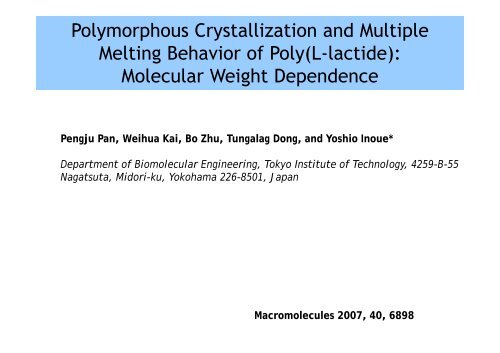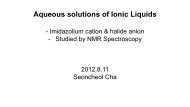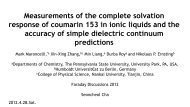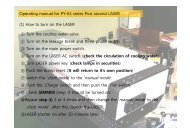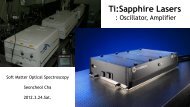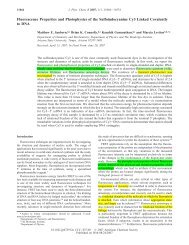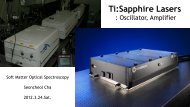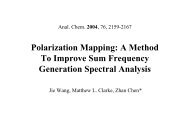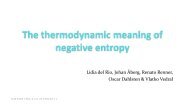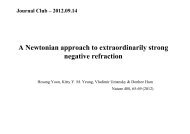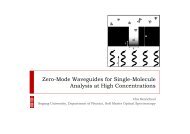Melting Behavior of Poly(L lactide)
Melting Behavior of Poly(L lactide)
Melting Behavior of Poly(L lactide)
You also want an ePaper? Increase the reach of your titles
YUMPU automatically turns print PDFs into web optimized ePapers that Google loves.
<strong>Poly</strong>morphous Crystallization and Multiple<br />
<strong>Melting</strong> <strong>Behavior</strong> <strong>of</strong> <strong>Poly</strong>(L-<strong>lactide</strong>):<br />
<strong>Poly</strong>(L <strong>lactide</strong>):<br />
Molecular Weight Dependence<br />
PPengju gj P Pan, WWeihua ih KKai, i B Bo Zh Zhu, TTungalag g l g DDong, g and d Yoshio Y hi I Inoue* *<br />
Department <strong>of</strong> Biomolecular Engineering, Tokyo Institute <strong>of</strong> Technology, 4259-B-55<br />
Nagatsuta Nagatsuta, Midori Midori-ku, ku Yokohama 226 226-8501, 8501 Japan<br />
Macromolecules 2007, 40, 6898
Introduction<br />
<strong>Poly</strong>morph PLLA crystals :<br />
α - form crystal : common and stable polymorph<br />
β - form crystal : stretching the α –form(at high drawing and high temperature)<br />
γ - form crystal : epitaxial crystallization<br />
α΄- form crystal : disordered form <strong>of</strong> α -form crystal
The crystal structure and morphology<br />
associates the mechanical and thermal properties<br />
- crystallization kinetics<br />
- crystalline structure<br />
- melting behavior<br />
governing i <strong>of</strong> f<br />
- the crystallization kinetics<br />
- polymorphism <strong>of</strong> polymer<br />
- polymorphic crystallization<br />
- melting behavior<br />
crystallization temperature<br />
molecular weight (MW)<br />
molecular weight (MW)
Experimental Section<br />
Materials : , number-average molecular weight (M n) : 15 KM n ~ 219 KM n<br />
Gel Permeation Chromatography (GPC) :<br />
Use to measure Molecular weight <strong>of</strong> the PLLA samples<br />
Differential Scanning Calorimetry (DSC) :<br />
Use to measure thermal properties <strong>of</strong> PLLA samples<br />
th the iisothermal th l melt-crystallization lt t lli ti experiment, i t<br />
melting at 200 °C for 2 min<br />
Coolling at a rate <strong>of</strong> 100 °C/min to the desired Tc h heating ti t to 200 °C at t 10 °C/ °C/min(or i ( 2 °C/ °C/min) i )<br />
at 90 °C ≤ Tc ≤ 130 °C, the isothermal melt-crystallization time is 60 min.<br />
at t T Tc > 130 °C and d T Tc < 90 °C °C, th the iisothermal th l melt-crystallization lt t lli ti ti time i is 240 min<br />
i
Polarized Optical Microscopy (POM) :<br />
Wide-Angle g X-ray y Diffraction (WAXD) ( ) :<br />
FTIR Spectroscop Spectroscopy :<br />
The sample place between two glass slides<br />
heat to 200 °C in a hot stage for 2min<br />
the sample quench to the desired T c<br />
Rigaku RU-200, working at 40 kV and 200 mA,<br />
Scans angles: 5°-50° at a rate <strong>of</strong> 1°/min.<br />
FTIR-6100 spectrometer+IMV-4000 multichannel infrared microscope+MCT detector<br />
PLLA sample place between two pieces <strong>of</strong> BaF 2 slides<br />
heat to 200 °C in a hot stage for 2min<br />
The sample quench to the desired T c<br />
study the melting behavior : after the melt-crystallization<br />
the t e sample sa ple heat eat from o T c to 190 90 °C C at 2 °C/min C
the cold-crystallization experiment :<br />
melting lti at t 200 °C f for 2 min i<br />
coolling to 0 °C at 100 °C/min<br />
reheating to 200 °C at 10 °C/min.<br />
the nonisothermal melt-crystallization experiment :<br />
melting g at 200 °C for 2 min<br />
coolling to 0 °C at 5 °C/min
peak k shifts hift<br />
Difference <strong>of</strong> ~10 °C between PLLA219 and PLLA15 in T g, T m, and T m 0<br />
Mn: number-average molecular weight<br />
Mw: weight-average molecular weight<br />
T g : glass g transition temperature p<br />
Tcc : cold crystallization temperature<br />
Tm : melting temperature<br />
T0 m : equilibrium q melting g temperature p
Results and Discussion<br />
Crystallization Kinetics<br />
Figure 1. DSC thermograms <strong>of</strong> (a) cold<br />
crystallization at a heating rate <strong>of</strong><br />
10 °C/min and<br />
(b) nonisothermal melt-crystallization<br />
at a cooling rate <strong>of</strong> 5 °C/min for PLLA<br />
with various MWs.<br />
the effect <strong>of</strong> various MWs on the isothermal crystallization<br />
With decreasing MW,<br />
the crystallization peak shifts to higher temperature<br />
and becomes much sharper,<br />
the crystallization rate increases<br />
the crystallization mechanism changes<br />
the crystallization cannot be finished
the effect <strong>of</strong> T c on the crystallization behavior<br />
=(T c)<br />
=(T c)<br />
Figure 2. (a) Peak time (t p) and (b)<br />
spherulite radius growth rate (G) <strong>of</strong> PLLA<br />
with various MWs as a function <strong>of</strong> Tc.<br />
critical iti l ttemperature t (110°C) is i almost l t not t affected ff t d b by MW MW.<br />
tp value increases suddenlyy<br />
p<br />
crystallization is fastest<br />
almost not influenced by MW<br />
multipeaked spherulite growth kinetics<br />
the difficulty in nucleation at low undercooling<br />
and the poor diffusivity at high undercooling<br />
bell-shaped growth
- the lower MW samples show much faster crystallization rate than those <strong>of</strong> the<br />
higher MW ones.<br />
the mobility <strong>of</strong> polymer chains improve<br />
the much easier diffusion <strong>of</strong> polymer chains<br />
- the crystallization kinetics are strongly dependent on the MW <strong>of</strong> PLLA.
Crystalline Structure<br />
two dominant diffraction peaks<br />
Figure 3. 3 (a) WAXD patterns and (b)<br />
enlarged WAXD patterns <strong>of</strong> PLLA15<br />
isothermally melt-crystallized at Tc = 80-<br />
140 °C.<br />
appears<br />
disappears<br />
Figure 4. (a) WAXD patterns and (b)<br />
enlarged l d WAXD patterns tt <strong>of</strong> f PLLA219<br />
isothermally melt-crystallized at Tc =<br />
80-140 °C.
IR spectra <strong>of</strong> the C=O stretching band (1810-1710 cm-1)<br />
(dominant band)<br />
Figure 5. IR spectra in the 1810-1710<br />
Figure 5. IR spectra in the 1810 1710<br />
cm-1 region <strong>of</strong> amorphous and<br />
crystalline PLLA15 isothermally meltcrystallized<br />
at T c = 80-140 °C.<br />
so weak three new bands<br />
shifts toward lower wavenumber side by about 1 cm-1
WAXD patterns and IR spectra<br />
100-120 °C : the mixture <strong>of</strong> α΄- and α-form crystals y<br />
α -form crystal is produced at high T c<br />
α΄ -form crystal is produced at low T c<br />
the crystallization kinetics change discontinuously (Figure 2)<br />
According to Zhang et al.,<br />
-both the α΄- and α -form crystals have the same 103 helix chain conformation and<br />
orthorhombic unit cell<br />
- the packing <strong>of</strong> the side groups in the helical chains <strong>of</strong> the α΄-form crystal is less<br />
ordered and looser than that <strong>of</strong> the R-form crystal.<br />
Because the different crystal modifications usually have the different crystallization<br />
kinetics(the different nucleation or growth mechanisms) , it is reasonable to consider<br />
that the discontinuousness <strong>of</strong> crystallization kinetics is due to the polymorphism <strong>of</strong><br />
PLLA.
DSC Measurements on the <strong>Melting</strong> Processes<br />
a small and broad<br />
endotherm d th (P2)<br />
Figure 6. DSC heating curves <strong>of</strong> (a) PLLA15<br />
and (b) PLLA118 isothermally meltcrystallized<br />
at various T cs.<br />
small exotherm<br />
small exotherm disappears,<br />
two endotherms (P ( 1 and P2)present 2)p<br />
one endotherm (P1) appears
In Situ Observation on <strong>Poly</strong>morphic <strong>Melting</strong> <strong>of</strong> High-MW PLLA<br />
The C=O bands are greatly sensitive to the crystalline<br />
structure <strong>of</strong> PLLA(in Figure 5) 5).<br />
The C=O bands are mainly evaluated here.<br />
1850-1700 cm-1 : C=O stretching band group<br />
1300-1000 1300 1000 cm-1 cm 1 : C-O-C C O C, CH CH3 3, C-CH C CH3 3, and their coupling Vibration<br />
Figure 7. (a) Temperature-dependent IR spectra, (b) difference<br />
spectra calculated by subtracting the initial crystalline spectra (at<br />
140°C) 140°C), iin th the 1850 1850-1000 1000 cm-11 range ffor PLLA118 iisothermally th ll melt- lt<br />
crystallized at Tc =80°C registered in the heating process at a rate <strong>of</strong><br />
2 °C/min from 140 to 182 °C. (c) Second derivatives <strong>of</strong> the spectra<br />
collected before (at 140 °C) and after (at 182 °C) melting.
the peak p shift to lower wavenumber <strong>of</strong> C=O band<br />
linear change<br />
I 1759 increase<br />
drastic increase <strong>of</strong> I 1749<br />
Fi Figure 8 8. ( (a) ) DSC hheating i curve,<br />
temperature-dependent (b) wavenumber<br />
<strong>of</strong> the C=O stretching band, and (c)<br />
normalized intensity <strong>of</strong> the 1759 and 1749<br />
Figure 9b<br />
cm-1 bands for PLLA118 isothermally<br />
meltcrystallized at Tc = 80°Cduring the<br />
heating process at a rate <strong>of</strong> 2 °C/min.<br />
Figure 9a<br />
increase <strong>of</strong> the content <strong>of</strong> the amorphous phase<br />
C=O band shifts toward lower wavenumber
Figure 9. Temperature-dependent IR<br />
spectra in the 1800-1720 cm-1 range for<br />
PLLA118 isothermally melt-crystallized<br />
at T c = 80°C registered in the heating<br />
process at 2 °C/min from (a) 144 to<br />
160°C and (b) 162 to 180°C.<br />
Figure 8, Figure 9<br />
- α΄- to α-crystalline phase transition occurs<br />
prior to the major melting<br />
-C=O band <strong>of</strong> the α΄-form crystal locates at higher<br />
wavenumber than that <strong>of</strong> the α-form crystal.
To study the effect <strong>of</strong> T c on the melting process, using time- resolved FTIR<br />
spectroscopy.<br />
at T c = 100 °C,<br />
the I 1759 and I 1749 values have the very similar tendency<br />
<strong>of</strong> variation as those <strong>of</strong> PLLA118 crystallized at T c =<br />
80°C<br />
Figure 10. Temperature-dependent normalized<br />
intensity <strong>of</strong> the (a) 1759 and (b) 1749 cm-1 cm 1 bands<br />
for PLLA118 isothermally melt-crystallized at Tc = 100, 110, 120, and 140°C during the heating<br />
process at a rate <strong>of</strong> 2°C/min.<br />
indicating that the α΄- to α-crystalline phase transition<br />
occurs before melting.<br />
at Tc = 110 and 120 °C,<br />
the increase <strong>of</strong> I1759 disappears, but the increase <strong>of</strong><br />
I1749 is much weaker before the dominant melting.<br />
the α΄- to α-crystalline phase transition and<br />
the melting <strong>of</strong> the original α -form crystal.<br />
at Tc = 140 °C,<br />
no increase <strong>of</strong> the I1749 value before the<br />
melting is observed observed, and also the I 1749<br />
value decreases monotonously in the<br />
heating process<br />
direct melting <strong>of</strong> the α-form crystal.
In Situ Observation on <strong>Poly</strong>morphic <strong>Melting</strong> <strong>of</strong> Low-MW PLLA<br />
Figure 11. (a) DSC heating curve and (b)<br />
temperature-dependent normalized intensity<br />
<strong>of</strong> the 1759 and 1749 cm-1 cm 1 bands for PLLA15<br />
isothermally melt-crystallized at Tc = 80 °C<br />
during the heating process at a rate <strong>of</strong><br />
2 °C/min.<br />
the broad endothermic peak consists <strong>of</strong> two parts<br />
- at T < 140 °C,<br />
I 1759 value first decreases<br />
- nearby 145 °C,<br />
I 1759 increases<br />
- at T < 145 °C,<br />
I 1749 value increases gradually<br />
- at 145-154 °C,<br />
the sharper increase <strong>of</strong> the I 1749
Figure 12. Temperature-dependent normalized<br />
intensity <strong>of</strong> the (a) 1759 and (b) 1749 cm-1<br />
bands for PLLA15 isothermally melt<br />
crystallized at Tc = 100, 110, 120, and 140 °C<br />
during the heating process at a rate <strong>of</strong><br />
2 °C/min.<br />
at Tc = 100 °C,<br />
the I1759 and I1749 values have the very similar<br />
tendency <strong>of</strong> variation as those <strong>of</strong> PLLA15crystallized<br />
at Tc = 80°C<br />
the melting <strong>of</strong> the α΄-form α form crystal and α -form form<br />
crystal from occur simultaneously<br />
at T c = 120 and 140 °C, the I 1749 value does<br />
c , 1749<br />
almost not change during the heating process<br />
the α -form crystal is developed<br />
At Tc > 130 °C,<br />
the as-produced α -form crystal is perfect enough<br />
and it melts directly without the meltrecrystallization<br />
process,
Conclusions<br />
the melting <strong>of</strong> PLLA is found to be also greatly influenced by T Tc and MW<br />
In the PLLA crystallized at low Tc, the transition from disordered α΄- form crystal to<br />
ordered α-form crystal prior to the dominant melting was confirmed<br />
In the high- g MW PLLA crystallized y at low Tc, c,<br />
almost all the α΄-form crystals transform into the α -one in the heating scan<br />
In the low-MW PLLA crystallized at low T c,<br />
c<br />
the α΄-form crystals only partially transform into the α-one, and some amounts <strong>of</strong><br />
α΄-form crystals melt directly without transition during the heating process<br />
With the increase <strong>of</strong> T c, the melting <strong>of</strong> PLLA with various MWs changes from the phase<br />
transition + melting mechanism to the usual melt-recrystallization mechanism.<br />
the effects <strong>of</strong> Tc and MW on the polymorphism are quite important to interpret the<br />
peculiar p thermal behavior <strong>of</strong> PLLA as well as for controlling g the pphysical y pproperties p <strong>of</strong><br />
PLLA by optimizing the crystallization process.


